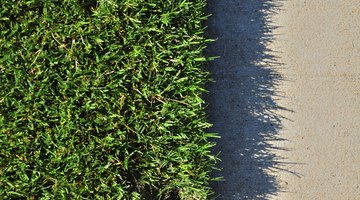How to Build a Concrete Mow Strip
A concrete mow strip serves as a divider between your flower beds and your lawn. Pavers, bricks and other items often create this division, but over time, they need replaced. Concrete lawn edging provides a permanent solution.

A mow strip is typically 6 inches wide and set level with the ground, so lawn mower blades can't hit the concrete when the mower passes overhead. Installing mow strips requires few tools and only a rudimentary knowledge of laying concrete.
Things You Will Need
- Shovel
- Bender board
- Stakes
- Hammer
- Nails
- Scrap lumber blocks
- Concrete mix
- Float
- Finishing tool
- Rake
- Grass seed
Tip
Make your mow strip at least twice as wide as your lawn mower’s wheels. Place mow strips so that they don’t interfere with your lawn’s irrigation system.
Warning
Clean all your tools thoroughly with running water as soon as you finish working with the concrete. Hardened concrete is difficult to remove.
-
Dig a 6- to 8 inch-deep trench where you plan to install the concrete lawn edging. Using your shovel, make the trench slightly wider than 6 inches.
-
Create walls to make the form for the mow strip, using flexible bender board at least 6 inches wide. Set two strips of bender board parallel with each other in the shape you want the concrete mow strip to take, with their tops level with the ground. Place stakes outside the form walls to hold them upright, especially on curved areas. Nail the bender board to the stakes for additional support.
-
Keep the width of the concrete mow strip stable and parallel by placing 6-inch blocks of scrap lumber between the bender board walls. Place the blocks 18 to 24 inches apart.
-
Mix the concrete in a wheel barrow or small concrete drum mixer with just enough water to make a thick slurry. Shovel the mix into the trench, and pack it firmly into the bender board form. Smooth the top with a hand float tool. Use a finishing tool to create a nice edge and simplify removing the bender board once the concrete sets.
-
Press the narrow edge of the hand float into the concrete when it stiffens to create the appearance of the junctions between two blocks of concrete. Try to keep the distance between junctions uniform.
-
Pull away the bender board forms. Allow the concrete to cure for at least 48 hours. Place fill dirt along the outside edge of the concrete mow strip. Smooth it with a rake. Sow some grass seed on the lawn side of the mower strip, and water it.
The Drip Cap
- A concrete mow strip serves as a divider between your flower beds and your lawn.
- Concrete lawn edging provides a permanent solution.
- Place stakes outside the form walls to hold them upright, especially on curved areas.
- Nail the bender board to the stakes for additional support.
- Keep the width of the concrete mow strip stable and parallel by placing 6-inch blocks of scrap lumber between the bender board walls.
References
Writer Bio
Denise Brown is an education professional who wanted to try something different. Two years and more than 500 articles later, she's enjoying her freelance writing experience for online resources such as Work.com and other online information sites. Brown holds a master's degree in history education from Truman State University.
Photo Credits
- Vernon Habersetzer/iStock/Getty Images
- Vernon Habersetzer/iStock/Getty Images
More Articles



